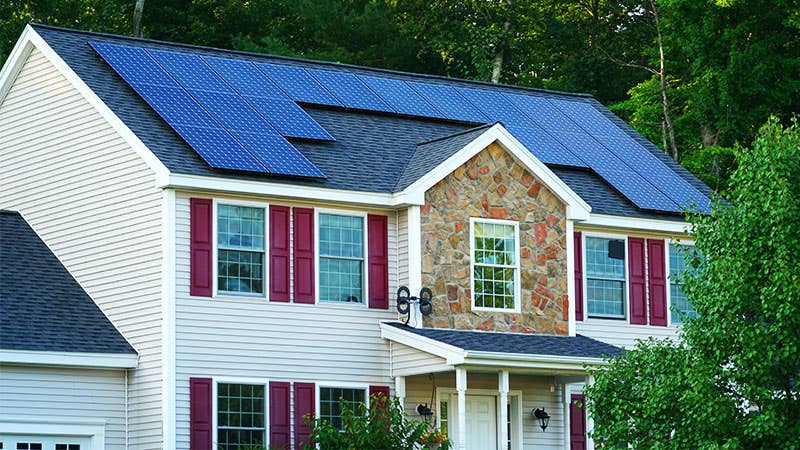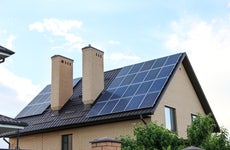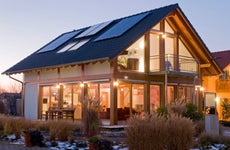Solar panel financing 101: Everything you need to know

The Bankrate promise
At Bankrate we strive to help you make smarter financial decisions. While we adhere to strict , this post may contain references to products from our partners. Here's an explanation for .
Key takeaways
- Solar panel systems have high upfront costs, but incentives help offset the total price.
- The total bill for solar panels includes costs both hard (the panels and related equipment) and soft (installation).
- Solar financing options are available to fit any budget, including solar loans, lease or power purchase agreement.
- Installing solar panels can lower energy bills and even improve your home's selling potential.
Adding solar power to your home can have many financial and environmental benefits. Solar panels can reduce or eliminate your electric bill, and the investment can also increase property value.
Unfortunately, solar equipment isn’t cheap. According to data from the Lawrence Berkeley National Laboratory, the average cost of a solar panel system in the U.S. is $31,558. That price tag might feel overwhelming, but the government will reduce your tax bill if you put a new system on your roof. The Inflation Reduction Act includes a 30 percent tax credit that applies to all eligible solar expenses. So, if you pay $30,000 to install a new system, you’ll qualify for a $9,000 tax credit.
Can solar panels save you money?
Interested in understanding the impact solar can have on your home? Enter some basic information below, and we’ll instantly provide a free estimate of your energy savings.
No matter how much you get to wipe away from your tax bill, the upfront cost can still be daunting. The good news is there are several solar financing options to help make solar panels more affordable.
How much do solar panels cost?
Before you can figure out how much solar panel financing you need, you’ll need to calculate the cost of those panels. The cost of each individual solar panel will vary depending on the type of panels you choose (more on that below) and the quantity you need to buy.
The number of panels you’ll need will depend on their efficiency, the size of your home and how much electricity you use. That said, an average-sized house will usually require 15 to 25 solar panels to cover its electricity bills fully, according to SaveOnEnergy. (SaveOnEnergy is owned by Bankrate’s parent company, Red Ventures.)
Types of solar panels and their costs
Solar panels come in three basic types:
- Monocrystalline solar panels are the most efficient of the three. They’re made from a single sheet of silicon, which is then divided into square-shaped solar cells. For each monocrystalline panel, you can expect to pay between $1 to $1.50 per watt (not including labor or installation expenses).
- Polycrystalline solar panels are created from multiple silicon crystals (rather than a single sheet). As a result, they’re less efficient but more affordable. They cost between $0.70 and $1 per watt.
- Thin-film solar panels are very versatile and have a high tolerance to heat. However, they’re the least efficient, so you’ll need more of them (and, therefore, more space) to power your home. As a result, they’re used mainly in commercial or industrial settings. You’ll pay around $1 to $1.50 per watt for thin-film panels.
Other costs
In addition to the hard costs of the panels themselves (along with inverters, solar batteries, conduit, electrical panels and racking equipment), there are also several other costs associated with a residential solar system, known as soft costs. Understanding the difference between the two is important to understand your total cost — and, consequently, the size of the loan for solar that you’ll need.
Solar costs by state
To help you get an idea of how much you’d pay to install a system — and how much you’d need to cover with solar panel financing — here’s a breakdown of costs by state.
-
State Average 5kW system price Average price per watt Source: Find Energy, data not available for Alaska, Alabama, Hawaii, Montana, Nebraska, North Dakota, South Dakota and Wyoming Mississippi $15,700 $3.14 Texas $16,683 $3.34 Florida $16,074 $3.21 Oklahoma $15,629 $3.13 Arizona $15,342 $3.07 Nevada $15,411 $3.08 South Carolina $17,271 $3.45 Delaware $15,433 $3.09 Connecticut $18,731 $3.75 California $17,356 $3.47 Tennessee $17,892 $3.58 West Virginia $16,930 $3.39 Virginia $17,960 $3.59 Missouri $16,839 $3.37 Kansas $16,700 $3.34 Georgia $18,677 $3.74 Louisiana $19,016 $3.80 Pennsylvania $17,772 $3.55 Maryland $17,695 $3.54 Arkansas $17,450 $3.49 New Hampshire $21,115 $4.22 Kentucky $18,250 $3.65 Ohio $17,074 $3.41 North Carolina $17,563 $3.51 New York $18,230 $3.65 Massachusetts $20,304 $4.06 New Jersey $17,629 $3.53 Idaho $17,278 $3.46 Oregon $17,521 $3.50 Utah $16,453 $3.29 Maine $19,015 $3.80 Illinois $18,777 $3.76 Indiana $20,476 $4.10 Rhode Island $20,370 $4.07 Washington $17,962 $3.59 Vermont $19,229 $3.85 Iowa $20,025 $4.01 Wisconsin $19,411 $3.88 Michigan $20,278 $4.06 Minnesota $20,163 $4.03 Colorado $19,888 $3.98 New Mexico $19,642 $3.93
How much money can I save by going solar?
You may get sticker shock when you see that it can cost tens of thousands of dollars to install solar power at your home. But it may still make financial sense because of the potential long-term savings. Your investment could pay off by significantly reducing or even eliminating your power grid usage. (Plus, since you have several options for solar financing, like personal loans or PPAs, you won’t have to cough up tens of thousands right away.)
According to the most recent data released by the Energy Information Administration, the state with the highest monthly electricity bill was Hawaii, with $177.78, while the lowest was $80.87 in Utah.
The total average for the entire United States worked out to $120.01, which is about $43,200 over 30 years. Depending on where you live and the tax incentives available, your total electricity savings could exceed the cost of your solar panel installation as long as you stay in the home long enough.
Using national averages for system size, price, and electricity bill, here is an example of how much you could save on energy bills with solar.
- System size: 7.2 kW
- Installed cost per watt: $4.20
- Total cost: $30,240
- Monthly electricity bill: $120.01
- Solar tax credit savings: $9,072 (30 percent of installed cost)
- Payback period: 14.7 years
- 20-year savings: $7,633
Your home’s location and energy consumption will ultimately determine what solar panels might cost you.
There are plenty of solar cost calculators online, which offer a cost and energy savings estimate. After entering your address, monthly bill, and a few other questions, you’ll get results about solar panel costs and savings predictions for your home. Some calculators will also break down the environmental impact your installation could have.
As you look at the savings that can add up in the big picture, be sure to consider the Residential Clean Energy Credit that you can apply to your taxes, which gives you a credit for 30 percent of what you spend on eligible solar costs. If you get a credit for the maximum of $9,000, for example, and you owe $7,000 in taxes next year, your federal tax liability will shrink to zero — and you’ll get to roll over that remaining $2,000 credit to the next year.
Best ways to finance solar panels
If you don’t have the cash on hand to cover the total cost of going solar, consider these solar panel financing options.
Personal loans
For many people, the best type of solar panel financing is probably a personal loan for solar. A personal solar panel loan will come with fixed interest rates and fixed monthly payments that never change during the life of the loan. Some home improvement loans have higher limits or longer terms to make it easier to pay for more expensive options.
Key benefits
Personal loans typically offer faster access to cash — sometimes in as little as a day or two — and many come with no origination fees. Also,a personal loan is unsecured, so you don’t have to put your home up as collateral or have a ton of home equity to qualify.
Key drawbacks
To qualify for the lowest rates for this kind of loan for solar, you’ll need good or excellent credit. If you don’t have the best credit, you may get stuck with sky-high interest rates that make this type of solar panel financing expensive.
Who is this best for?
Financing a solar panel purchase with a personal loan may be a good option if you need the loan proceeds quickly. It also makes sense if you have solid credit scores and will likely qualify for the most competitive interest rates.
FHA and Fannie Mae loans
There are also two types of mortgage loans — the FHA 203(k) loan and the Fannie Mae HomeStyle Renovation loan — that can help you simultaneously finance the purchase of a home and the installation of solar panels, as well as other renovations or upgrades.
Key benefits
Because the Fannie Mae HomeStyle Renovation loan allows as much as a 97 percent loan to value ratio, it’s easier to qualify for than some other loans. Also, you can use either of these programs to refinance your existing mortgage and pay for your solar upgrades, too.
Key drawbacks
Compared to alternatives like personal loans, and home equity loans/HELOCs, the FHA 203(k) loan may have higher interest rates. The Fannie Mae HomeStyle Renovation loan rates tend to be lower than the competition. Still, often there’s often more red tape involved in the application, and remodeling work must be completed within 12 months of getting the money. Fees and closing costs are usually higher as well.
Who is this best for?
The FHA and Fannie Mae loans may be the way to go if you’re purchasing a home and want to have solar panels installed simultaneously. They can also be smart choices for solar financing if you aren’t eligible for personal loans with reasonable rates.
Home equity loans and HELOCs
If you have a lot of equity in your home and prefer to borrow against it for your solar financing, you can also consider a home equity loan or a home equity line of credit (HELOC).
Home equity loans work like personal loans, as they have fixed interest rates, fixed repayment timelines and consistent monthly payments. HELOCs, on the other hand, give you a line of credit you can borrow against like a credit card. With HELOCs, you’ll typically have a variable interest rate, which means your payment could go up or down as your account balance and interest rate fluctuate.
Key benefits
If you can use your home equity and have good or great credit, home equity loans and HELOCs will usually come with low interest rates and fair terms. Another perk is that you may be able to deduct the interest you pay on them and save money on your taxes.
Key drawbacks
You can usually only borrow up to 85 percent of your home’s value across a first mortgage and second loan. In addition, home equity loans and HELOCs come with an application process that is more involved than the one for personal loans.
Who is this best for?
Home equity loans and HELOCs are a good choice for solar panel financing if you have sufficient equity in your home and have determined that solar panels are likely to add value to it. This kind of equity-backed loan for solar is also worth considering if you don’t qualify for a personal loan with a good rate because of your credit.
Power purchase agreement or solar lease
For solar buyers who want to avoid upfront costs and not have the responsibility for solar panel maintenance, a power purchase agreement (PPA) or solar lease may be a good fit. Both options can lead to lower energy costs, but the main difference is what you pay for in your monthly bill. In a PPA, you pay a specific price per kilowatt-hour (kWh) of solar energy generated, while in a solar lease, you pay a fixed monthly rate.
Key benefits
Both options have low upfront costs and lead to energy bill savings, plus you will power your home with clean energy instead of electricity from the grid. The solar company you have an agreement with is responsible for any needed maintenance or repairs to your solar system. If something works improperly, it is not up to you to fix it.
Key drawbacks
Solar lease and PPA contracts extend 25 to 30 years. If you plan to move homes, you must find someone willing to take over your contract. If they won’t, you may have to pay a hefty cancellation fee. Also, rates may increase over time, so review your contract for any annual rate increase information. Solar leases and PPAs do not qualify for incentives, like the federal solar tax credit or net metering. Over time, your savings will be lower than if you purchase a solar panel system with cash or a loan.
Who is this best for?
Solar PPAs or leases are best for those with financial restrictions who still want to power their home with solar energy and reduce their carbon footprint.
Contractor financing: Solar loans
Some of the best solar installers offer their own financing, often through a third-party lender that they partner with.
How long is a typical solar loan?
Usually, this type of solar loan comes with a term of 10–25 years.
Key benefits
Getting solar panel financing through your contractor can simplify the process for putting that loan in place. Plus, because the contractor is motivated to have the financing go through (so they can make money off your project), they may lower eligibility requirements.
Key drawbacks
Getting this kind of loan for solar might require a hard credit check. As a result, you might ding your credit score only to find out the contractor ultimately won’t approve you.
Some contractor financing also comes with underwriting fees.
Finally, given its length, this kind of loan for solar can mean paying more in interest over the life of the loan.
Who is this best for?
Homeowners who like the one-stop-shopping approach, and find that getting financing through their solar contractor wouldn’t mean a higher interest rate than other loan options.
Solar panel tax benefits
Solar panel costs can add up quickly. Fortunately, there are some tax incentives available to help you offset the costs.
One of the best benefits is the federal Inflation Reduction Act’s 30 percent tax credit on solar installations, available for homeowners who purchase and install solar panels on their primary or secondary residence in the United States. The credit runs through 2032 in an effort to continue to spur the solar shift. In 2033, the credit will drop to 26 percent, and in 2034, it will decrease to 22 percent before phasing out in 2035.
Depending on where you live, you may also be eligible for state-sponsored tax incentives. For example, some states allow you to exchange your surplus solar power for credits on your energy bill through a process called net metering. In other states, solar panels are exempt from sales tax. The Database of State Incentives for Renewables & Efficiency can help you explore your state-based options.
Next steps in installing solar panels
Solar energy is quickly growing in popularity, with some states even requiring that new homes come with solar panels or solar shingles. Solar offers reduced utility costs and the environmental upshot of generating renewable energy; they may even give a competitive edge when you sell your home. But do your homework — including exploring any and all of the solar financing options out there — before committing to such a large and expensive project.
Related Articles



